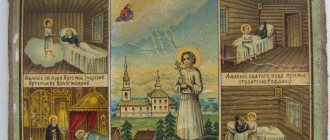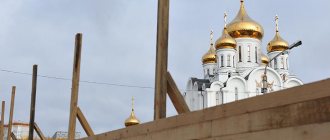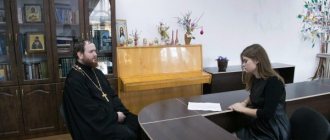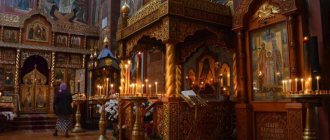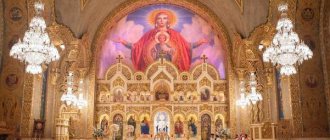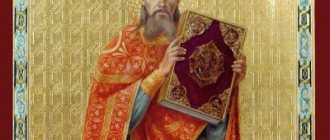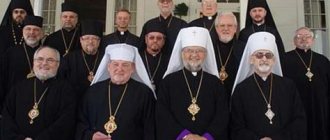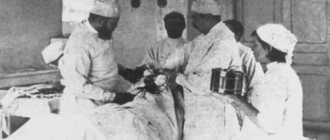| Grodno Intercession Cathedral. Photo from the site piligrim.by |
Grodno and Volkovysk diocese
of the Belarusian Exarchate of the Russian Orthodox Church
- Diocesan administration: Belarus, 230023, Grodno, st. Ozheshko, 23
- Tel.: +375; fax: +375
- Official website: [1]
- Canonical territory: Berestovitsky, Volkovysk, Voronovsky, Grodno, Zelvensky, Mostovsky, Svisloch, Shchuchinsky districts of the Grodno region.
- Cathedrals: Intercession Cathedral in Grodno, Peter and Paul Cathedral in Volkovysk
- On the map: Yandex.Map, Google map
Established on January 23, 1900, being separated from the Vilna diocese.
In 1924-1939, the Grodno diocese existed as part of the autocephalous Polish Orthodox Church.
In 1942, under pressure from the occupation authorities, the “Belarusian Orthodox Autocephalous Church” was organized in Belarus, which nevertheless managed to avoid a formal declaration of autocephaly and a canonical break with the kyriarchal government. Venedikt (Bobkovsky), who remained on the cafder until 1943, became the appointee of the Belarusian Synod to the Grodno cafdera.
At the end of the Second World War, the Grodno diocese continued to exist as part of the Russian Orthodox Church, but after 1960 it was discontinued.
The Grodno See was restored on February 18, 1992 by the decision of the Holy Synod of the Russian Orthodox Church.
Nowadays the Grodno diocese unites the parishes of the western part of the Grodno region. Cathedral city - Grodno.
Historical names
- Grodno and Brest (? - April 21, 1923)
- Grodno and Novogrudok (April 21, 1923 - 1940)
- Grodno and Vilna (July 1940 - 1940/1941)
- Grodno and Baranovichi (1940/1941 - 1942)
- Grodno and Bialystok (1942 - 1943)
- Grodno and Baranovichi (1945 - November 18, 1948)
- Grodno and Brest (November 18, 1948 - February 28, 1949)
- Grodno and Lida (February 28, 1949 - 1950)
- Grodno and Brest (1951 - 1955)
- Grodno and Volkovysk (since February 18, 1992)
Statistics
- 1912 - Churches - 612, chapels - 42; Monasteries - 5 (2 women's), 1 monastery courtyard; 1 religious school, 866 church schools; There are 183 libraries at churches, 26 at dean districts; Almshouse - 1 [2].
- January 1, 1995 - 72 parishes, 59 priests, 5 deacons. 9 Sunday schools, one church fellowship [3].
- OK. 2004 - 87 parishes; 86 clergy (81 priests, 5 deacons) [4].
- March 2012 - 94 parishes, 107 churches, 111 clergy (103 priests; 8 deacons) [5]
Archpastors
- Joachim (Levitic) (January 13, 1900 - November 26, 1903)
- Nikanor (Kamensky) (November 26, 1903 - December 9, 1905)
- Mikhail (Ermakov) (December 9, 1905 – 1921) [6]
- Vladimir (Tikhonitsky) (not earlier than September 1918 - late 1922) high school, ep. Bialystok
- Alexy (Hromadsky) (October 12, 1922 - April 15, 1934)
- Anthony (Martsenko) (1934 - 1936/1937)
- Savva (Sovetov) (1936/1937 - 1939)
- Panteleimon (Rozhnovsky) (October 17, 1939 - 1941) until July 1940 - high, archbishop. Pinsky
- Venedikt (Bobkovsky) (April 1942 - 1943)
Formation of the Orthodox diocese
In addition to the Catholic diocese, there is also an Orthodox diocese in the city of Grodno. It was formed in 1900 on January 23. The Grodno Orthodox diocese was separated from Vilna and Lithuania. It was under their leadership that it was until 1900.
If we talk about the history of the emergence of Orthodoxy in this place, the chronicles tell that stone churches appeared here already in the twelfth century. The most ancient ones that have survived to this day are the Upper and Lower churches.
Initially, this place belonged to the Kyiv Metropolis, and in the fourteenth century it came under the rule of the Lithuanian-Novogrudok Metropolis. Its center was in Novogrudok. The Union of Brest redrawn some Orthodox allotments, and after its adoption this metropolitan see became Uniate. This continued until the eighteenth century, when the Polish-Lithuanian Commonwealth experienced several divisions. Orthodoxy began to gradually return to these places.
The first bells were the request of the Orthodox to restore the church and re-consecrate it into the St. Sophia Cathedral. This happened in 1804. Then, in 1843, a convent was built in Grodno. During this period, the diocese had churches, monasteries, and church schools under its rule.
Already in 1923, some part of this diocese became part of the Polish Orthodox Church. This was the beginning of the loss of controlled churches. Some of them were given to Catholics, and some were simply closed. This period was marked by the Polishization of Orthodoxy: the service was read in Polish.
The history of the diocese before 1992 is quite chaotic. It passed from one subordination to another several times, only in the early nineties of the last century it began to be restored.
Geography of deaneries
- Grodno:
- Grodno
- g.p. Bolshaya Berestovitsa, Golni village, Gorbachi village, Klepachi village, Malaya Berestovitsa village, Massolany village, Olekshitsy village, Border
- Volkovysk, Vereyki village, Volpa village, Dyatlovichi village, Isobelin village, Kolontai village, Krasnoselsky, Podorosk village, settlement Ros, Sidelniki village
- g.p. Voronovo, village Zabolot, urban settlement Radun,
- Zelva village, Golynka village, Derechin village, Dobroseltsy village, Mizherici village, Ostrovo village, Slovatichi village, Synkovichi village
- Mosty, Belavichi village, Gudevichi village, Dubno village, Lunno village, Peski village, Samuilovichi village, Cherleny village
- Svisloch, Gornostaevichi village, Dobravolya village, Novy Dvor village, Polonka village, settlement Porozovo, Sventitsa village, Khoroshevichi village, Yatvesk village
- Skidel, Vertelishki village, Golovachi village, Gushchitsy village, Zhidomlya village, Indura village, Komotovo village, Koptevka village, Lasha village, Milkovshchina village, Ozery village, Porechye village, Svisloch, town Sopotskino
- Shchuchin, Bershty village, Vasilishki village, Goluby village, Dembrovo village, settlement Zheludok, Murovanka village, Naroshi village, Orlya village, settlement Ostrino, Pervomaiskaya village, Rakovichi village, Rozhanka village, Tureisk village, Shnipki village, Shchenets village
Church and public organizations
- Diaconal station of the Grodno diocese, Grodno
- St. Vladimir Brotherhood, Grodno (since 1993)
- Boris and Gleb Brotherhood, Grodno (since 1997)
- Sofia Youth Brotherhood at the Intercession Cathedral, Grodno
- brotherhood in the name of St. martyr Gabriel of Belostotsky at the Kazan Church, village. Porechye
- sisterhood of St. right Juliana Olshanskaya at the Intercession Cathedral, Grodno
- sisterhood in the name of the martyrs Vera, Nadezhda, Lyubov and Sofia at the parish in honor of the Council of Belarusian Saints, Grodno
- sisterhood in the name of St. martyr Tryphon at the Elias Church, Mosty
GRODNO AND VOLKOVYSK DIOCESE
Majolica decor on the facade of Borisoglebskaya (Kolozhskaya) Church. Photo. 2006
Majolica decor on the facade of Borisoglebskaya (Kolozhskaya) Church. Photo. 2006 On the territory of Gorodno, which was in the XII - 1st half. XIII century the center of the appanage principality, the most ancient monuments of this region are preserved. Archaeological excavations on Castle Hill (1932-1933, 1937-1939 - Polish scientists J. Jodkowski, J. Wojciechowski, Z. Durchevsky; 1949 - N. N. Voronin) revealed the existence here at the end. XI century wooden fortress.
In the 2nd half. XII century on the right high bank of the river. Neman, opposite Castle Hill, the Borisoglebskaya (Kolozhskaya) Church was built. (80s of the 12th century; not completely preserved: the chapter was lost until the 18th century; southern and part of the western wall, southern apse - in the 2nd half of the 19th century) (see Art. Grodno Kolozhsky Monastery in the name of the martyrs Boris and Gleb).
In con. XII century a stone, so-called, was built on Castle Hill. Lower Church (preserved parts of walls up to 3.5 m high and pillars, fragments of structures and decor). The church was a rectangular building (16.8´ 11.6 m), with sloping corners, oriented along the east-west axis, with 6 pillars, 4 of which with cut corners supported a dome shifted to the west, and 2 were probably a continuation of the internal walls that separated the apses and had arched openings. Of the 3 apses of the temple, only the central one was structurally separated; the side ones had niches to the east. walls. It is assumed that the temple had a mosquito cover. The entrances were located from the west, north. and south parties; entrance openings and windows had arched ends. In the southwest in the corner, a fragment of a twisted staircase leading to the choir has been preserved. The walls were made of plinth in a continuous row of masonry with the inclusion of boulders and jugs. The facades, as well as the internal walls, were divided by blades, corresponding to the arrangement of pillars in the interior; the corners of the scapula were missing. The temple was decorated with majolica inserts in the shape of a cross and rosettes in brown and green colors. The surviving floor is laid out in diagonal rows of majolica tiles in green, yellow and brown; in the space under the dome, the floor pattern consists of 5 ornamented circles inscribed in an equal-ended cross.
During the same period, the 6-pillar Prechistenskaya Church was built. on Podol in Gorodno (since 1635 the temple of the Basilian monastery, since 1843 the Orthodox (see Art. Grodno convent in honor of the Nativity of the Blessed Virgin Mary); preserved foundation); the construction of a 6-pillar temple in Volkovysk supposedly stopped at the foundation level.
"Podol" in Grodno. Engraving by M. Zandt. Ser. XVI century (RNB)
"Podol" in Grodno. Engraving by M. Zandt. Ser. XVI century (RNB) A distinctive feature of the local architectural school was the “decoration of building facades with multi-colored stone inserts and majolica tiles (Lower and Kolozhskaya churches)” (Belarusian Archeology, p. 102). The Goroden school of architects was a synthesis of the Volyn (building traditions) and Polotsk (architectural forms and brick production) schools (Rappoport P, A. Architecture of the 12th century on the territory of Belarus // Old Russian state and Slavs: Materials of the Minsk Symposium, 1983. pp. 116-118; cf.: Chernyavsky I. M. Prechistenskaya Church of the 12th century // Ibid. pp. 119-121).
All R. XIII century Gorodno became part of the Grand Duchy of Lithuania. No information has been found about the construction of stone temples during this period. In con. XIV century led book The Lithuanian Vitovt replaced the wooden fortress of the city with a stone one and built a new princely palace in the Gothic style (Old, or Upper Castle), and not far from the gates of the fortress - the so-called. The lower castle, also surrounded by stone walls. In zap. parts of the Old Castle, on the site of the Lower Church, at the end. XIII - beginning XIV century a small so-called Upper Church (Resurrection) (discovered by archaeologists in 1933, moved to a separate pavilion of the Grodno Historical and Architectural Museum; the eastern half of the foundation, part of the southern wall with the southwest corner, the bases of 2 pillars and part of their masonry are preserved). The masonry technique of the Upper Church is close to the masonry technique of the Lower and Borisoglebskaya (Kolozhskaya) churches, which indicates that it belongs to the Grodno school of architecture. The plan is similar to the ancient Russian one. single-apse churches: a square building (8.9´ 8.9 m) with cut corners, oriented along the axis of the Lower Church, with a semicircular apse equal in width to the main volume, with an entrance from the west. sides, possibly with vaulted ceilings; in the apse opening there were 2 cross-shaped pillars with cut corners.
Sources of the 16th century They report the existence of several in the city. Orthodox churches, most of which were wooden (Voskresensky, Trinity, Nikolaevsky, Simeonovsky, Krestovozdvizhensky). In place of the modern Monastery of the Nativity of St. Mother of God there was a stone Prechistenskaya church. (according to archaeological data, built in the 12th century, first mentioned in documentary sources in 1506, destroyed by fires in 1647 and 1654, foundation preserved). A general view of the city and a schematic representation of its temples is shown in the engraving of 1568-1572. (Braun G. Civitates orbis terrarum colonial. Köln, 1576).
Church in honor of the Nativity of St. Mother of God in the village Murovanka (Malomozheikovo). 1st half XVI century Photo. Beginning XX century
Church in honor of the Nativity of St. Mother of God in the village Murovanka (Malomozheikovo). 1st half XVI century Photo. Beginning XX century From the end XV to mid. XVII century On the lands of the Grand Duchy of Lithuania, stone defense-type churches were erected. The prototype of such structures was the St. Sophia Cathedral in Polotsk, rebuilt into a con. XV - beginning XVI century to the temple-fortress, on the territory of the Grodno region, this is Orthodox. churches in honor of the Nativity of St. Mother of God in the village Murovanka (Malomozheikovo) and in the name of the architect. Mikhail in the village Synkovichi. The influence of ancient Russian can be traced in the architecture of these temples. and zap. building traditions, as well as European achievements. Renaissance. Ts. in honor of the Nativity of St. Mother of God in Murovanka (1524; significantly damaged in 1656, during the Russian-Polish War, and in 1706, during the Northern War, from the shelling of the troops of Charles XII; in 1871-1872 it underwent major repairs) - rectangular in plan (15´ 13 .5 m) 4-pillar building with a semicircular apse, almost equal in width to the temple, 4 towers at the corners of the main volume, covered with a 2-slope roof with a high gable on the west. façade The external design of the temple has a tiered structure: the 1st tier is completely devoid of decor; in the 2nd tier south. and sowing the walls have 3 windows (enlarged during renovation in the 19th century), deepened into perspective niches, between the windows there are 2 high narrow niches, on the towers there are a number of double niches that serve as decorative decoration for the loopholes; The 3rd tier of the side facades is decorated with double niches in the Renaissance style. The main façade is decorated with 3 equal-sized niches with arched ends, and in the central one there is a round window. Higher up, along the entire perimeter of the walls and towers, there is a row of loopholes under a profiled cornice that completes the facades. The figured gable is divided into 3 tiers by Renaissance arcature and completed, like all towers, with a cross on the “apple”. The apse is decorated with 3 windows, as on the facade. Semicircular niches decorate the eastern part. the wall of the temple is higher than the apse. In the interior, 8-sided pillars with profiled bases and capitals divide the space into plan cells, covered with star-shaped vaults with ribs; the apse is separated from the main volume by a wide pointed arch; in zap. parts are placed choirs, supported by 2 pillars. The temple was painted, but the frescoes were not preserved. In the 19th century the appearance of the church was changed as a result of renovations (1817, 1871-1872): a low vestibule with decorative turrets in front was added to the main facade, to the west. the towers were built on one tier, where the bells were placed, to the east. The spiral staircases in the towers were dismantled, the roofs were lowered, the cornices of the walls were re-laid, the window openings were enlarged, and some of the loopholes were filled in. Until the beginning XIX century The entrance to the temple had lift-up doors.
Plan c. in the name of the arch. Mikhail in the village Synkovichi. 1st half XVI century
Plan c. in the name of the arch. Mikhail in the village Synkovichi. 1st half XVI century Church in the name of Arch. Michael in Synkovichi (1st half of the 16th century, the apses and eastern towers may have been rebuilt later) is close in architecture to the church in Malomozheykovo: it is a rectangular in plan, 4-pillar building, covered with a high 2-slope roof, with 4 defensive towers in the corners (the western towers are faceted, the eastern ones are round in plan). The 3 apses are united under one roof thanks to a system of stepped transitions between the upper parts of the semicircular apses. The facades of the temple and the apse have lancet windows, recessed into niches (2 on the northern and southern walls, 1 on each apse and western facade). West, north, south the walls are completed with a cornice that goes to the towers and divides them into 2 tiers; loopholes and machicolations are arranged in the cornice. The pediment of the main facade is decorated with 5 rows of single, double and triple niches, the pediment is east. facade - double niches; originally the niches were whitewashed. The apse is decorated with an arcature belt that extends to the east walls. towers In the interior, 4 pillars support cross vaults with ribs; central and northern the apses are covered with cross vaults, south. apse - star-shaped. The square-based pillars above are 8-sided with 4 concave edges. The inner walls of the church are divided by blades, which are combined with pillars by supporting arches. Twisted staircases located in the towers connect the space of the temple with the room above the vaults, where the defensive tier is located. In 1880-1881 with zap. a vestibule was added to the side, a dome was built over the apse, and a 2-tier belfry, square in plan, topped with a tent, was built in front of the temple.
In 1494 he led. book Alexander of Lithuania founded the 1st Catholic Church in Gorodno. (Bernardine) husband mon-ry. In the XVI-XVII centuries. Mon-ri plural appeared here. Catholic orders Churches (Dominican, 1551 or 1553; Bernardine women, 1620; Franciscan, 1635; Brigitan, 1643; Carmelite, ca. 1650), Jesuit mission (1622, from 1625 residence, from 1664 college) and church (1647-1663, consecrated 1667, frescoes of the mid-18th century), Uniat. Basilian monastery (1626). Most of the buildings of this period were built in the Baroque style.
The vault of the side apse c. in the name of the arch. Mikhail in the village Synkovichi. Photo. 2006
The vault of the side apse c. in the name of the arch. Mikhail in the village Synkovichi. Photo. 2006 The conclusion of the Union of Brest (1596) interrupted the construction of the Orthodox Church. churches on the Grodno lands. Until the end XVIII century Grodno remained Catholic. and uniat. city. In 1700, the construction of a Jesuit church was completed here, in 1701 a Dominican church was built, in the middle. XVIII century The Carmelite and Franciscan churches were rebuilt. In 1728, the Bonifrater monastery arose. In 1726-1751. according to the Italian project. architect I. Fountains built a stone Uniat Cathedral. Basilian Monastery in honor of the Nativity of St. Mother of God in Grodno (consecrated in 1756; converted to Orthodox in 1843; see Art. Grodno Convent in honor of the Nativity of the Blessed Virgin Mary).
Construction of Orthodox churches in this area were restored only after the partitions of Poland and the annexation of this territory to Russia (1795) (architect Michael’s church in Izabelina, late 18th century, 1863, 1924). In 1807, as Orthodox. the cathedral in honor of St. Sophia was consecrated by the far church in Grodno (late 16th century; rebuilt in 1753, 1782; transferred to the Orthodox in 1804, to the Catholics in 1929; blown up in 1961). The original building, using Gothic and Renaissance styles and elements of defensive architecture, was a 3-nave single-tower basilica with a 5-sided apse, side sacristies and a chapel; The 4-tier rectangular belfry tower was flanked by cylindrical defense towers; Between the lancet windows of the side facades there were buttresses, united at the top by an arcature. In the 70s XIX century The cathedral was rebuilt by architect. S. P. Guryev in retrospective-Russian. style; after the fire of 1892, it was again rebuilt according to the design of the Warsaw diocesan architect. N. M. Chagina in Russian-Byzantine. style; repairs made after the fires of 1923 and 1935. architects V. Ganeberg and A. Sosnovsky, gave the temple neo-Gothic features.
In con. XVIII - 1st half. XIX century Among the buildings in the Grodno region, the prevailing type of temple originated from the wooden church buildings of Belarus: these are rectangular hall churches with a 2-slope or hip roof, sometimes with a dome on it, with 1 semicircular or rectangular apse, not distinguished from the outside, with a tower- belfry, built above the entrance or attached to the temple from the west. sides. Similar architectural compositions were characteristic of both stone and wooden architecture (stone church of St. George in Slovatichi, late 18th - early 19th centuries; wooden: church in honor of the Transfiguration of the Lord in Komotovo, 1844-1846; . apostles Peter and Paul in Volpe, 1859). From the end XVIII century stone construction in Belarus, including on the Grodno lands, developed in connection with the architecture of Russia and the classical style, the features of which were manifested in typological traditions. buildings. Yes, c. St. Nicholas in N. Samuilovichi (1st half of the 19th century) has a classic rusticated interior. facade with a high attic and triangular pediment; wooden c. Nativity of the Most Holy The Virgin Mary in Patsevichi (1867) is decorated with a belfry above the entrance in the form of a classic rotunda gazebo. In architecture c. St. Anna in Zadvoryany (1st half of the 19th century) the traditions of local architecture in combination with the classical style are most clearly visible: it is a rectangular building with a 2-slope roof, above the west. part of the cut is a small dome with a cross; a semicircular apse of the same height as the temple; rectangular extensions with 2-pitched roofs adjoin the apse on both sides. Zap. The façade is designed in the style of classicism: a 3-tiered 4-angled bell tower, with a middle tier decorated with columns and a 3-angled pediment, built into the west wall. facade, edges wider and higher than the main volume of the temple.
Church in the name of St. Nicholas the Wonderworker in the village. Dubno. 1844, 1864 Photo. 2006
Church in the name of St. Nicholas the Wonderworker in the village. Dubno. 1844, 1864 Photo. 2006 Using certain features of the Empire style, traditions were built. rectangular in plan churches with 2-pitched roofs: the Apostles Peter and Paul in Gornostaevichi, with a 6-column portico in front of the entrance (1st half of the 19th century); in honor of the Intercession of the Holy. Virgin Mary in Belavichi (1822), decorated with pilasters.
The buildings of this style include the monumental c. St. Nicholas in Dubno (1844, reconstructed in 1864 by the provincial architect V. Michaelis) with an inscribed cross type plan, 5 onion domes (on a high round drum above the middle cross and 4 on the towers above the corner cells), a rectangular central apse with adjacent rounded apses of the aisles. All facades are divided into two tiers by a cornice, end with attics, and are decorated with rows of semi-circular and semi-circular windows above the doors, designed to the same scale. In the interior, 4 pillars of a complex trapezoidal shape support the dome on a light drum, where paintings have been preserved (Deesis in the dome and images of saints in the drum).
Since the 60s XIX century churches in the Grodno region were built mainly in retrospective Russian. style; The most common type has become a small parish church with an axial composition (bell tower - refectory - temple - altar), a cubic square main volume in plan, covered with a 4-slope roof with a dome on it, round or rectangular, sometimes with beveled corners, an apse, a tiered bell tower , topped with a tent (similar structures are known in the Minsk and Brest regions). One of the first such buildings was the c. arch. Mikhail in the city of Shchuchin (1863), north. and south the facades are divided into pilasters into 3 sections with high windows with lancet archivolts, completed with cornices with a curb and large kokoshniks (keel-shaped in the corners, triangular in the center), reminiscent of a mosquito cover. The faceted roof is topped with a bulbous dome on a blind neck. The 2-tier bell tower is completed with a tent; its lower volume, rectangular in plan, is decorated, like the temple, with pilasters at the corners and a cornice with a curb; The upper 8-sided tier of the bell has 4 arched openings, decorated with columns and lancet archivolts.
Church in honor of the Dormition of St. Mother of God in the village Koptevka. 1864–1868 Photo. 2006
Church in honor of the Dormition of St. Mother of God in the village Koptevka. 1864–1868 Photo. 2006 In April 1864 in Grodno province. the so-called Temporary Committee for the Construction of Orthodox Church. churches, in 1865 renamed Grodno provincial, in 1868 - Grodno province. church-building presence headed by the city governor. The competence of the presence included: supervision of the state of the Orthodox Church. churches and perestroika catholic. churches to Orthodox, drawing up projects and estimates of buildings. During the 22 years of operation of the presence, approx. 100 temples, many of which were built according to standard designs using local rubble stone, often without finishing with plaster on the outside. Thus, the Church of the Intercession of the Holy Virgin is similar in architecture. Mother of God in the village Orlya, Holy Spirit in the village. Lakes (both - 1866) and Pokrova in the village. Pervomaiskaya (2nd half of the 19th century), the main cube-shaped volumes with 4-slope roofs and domes are decorated with wide rustication at the corners, an arcature belt under the cornice; to the north and south The facades and side faces of the rectangular apses have biforium windows surrounded by lancet archivolts. The 3-tier bell towers with tents are decorated in the same way, with minor differences in decoration.
The following churches were built according to a single project: Uspenskaya in the village. Koptevka (1864-1868), St. Demetrius in the village M. Berestovitsa (1866), Dormition of the Most Holy. Mother of God in the village Jatvesk (1873-1876), St. Nicholas in the village Rymki (1876). All buildings are made of rubble stone, unplastered, the corners of the volumes are decorated with pilasters, the facades are completed with archature friezes; semi-circular windows (double on the facades of churches and refectories, single on the walls of the lower tier of the refectory) are framed in the form of rays. The 3-tier bell towers (the 2 lower tiers are square in plan, the bell tier is octagonal) are decorated with stylized arcature belts, kokoshniks over the bell arches, and are topped with tents. Similar temples continued to be built in this area in the beginning. XX century (Church of the Nativity of the Blessed Virgin Mary in the village of Rakovichi, 10s of the 20th century). Church in honor of the Dormition of St. Mother of God in the village Golni (1903) generally repeats the composition and decor of monuments of this type, but has eastern, northern. and south On the sides of the main volume there are 3 semicircular apses, giving the temple the shape of a triconch.
Church in honor of the Transfiguration of the Lord in the village. Derechin. 1865 Photograph. 2006
Church in honor of the Transfiguration of the Lord in the village. Derechin. 1865 Photograph. 2006 Church of the Intercession of the Holy. Mother of God in the village Olekszycy (1865-1871, project by architect Michaelis), preserving the composition typical for the specified period, belongs to another series of buildings. The temple has a cube-shaped volume with a low 4-slope roof, crowned with a fairly large onion dome on an 8-sided drum; the apse is rectangular in plan, with chamfered corners; a refectory and a 2-tier bell tower, topped with a tent with an onion dome, were added to the west. The temple is plastered, decorated at the corners of the volumes with pilasters with decorative niches, lancet windows (2 on the northern and southern facades, 1 each on the side faces of the apses, the walls of the refectory and the bell tower) and bell arches. The typical design of the lips is close to the architecture of this temple. architect I. Kalenkevich, used in the construction of the Holy Cross churches in the village. Golovachi and St. book Alexander Nevsky in the village. Indure (both 1881, project 1877). Unlike the church in Olekszycy, these buildings have large 5-sided apses, a different design: more developed cornices with a paneled frieze, keel-shaped framing of windows and arched bell openings.
Typologically different from the listed buildings are churches with a plan in the form of a cross. Yes, c. Transfiguration of the Lord in the village. Ostryna (1875) has a central cubic volume with beveled corners, adjacent to the rim are equal east. (apse), north. and south (altars) and extended west. (refectory) sleeves of the cross. An 8-sided tent with a crease with a bulbous dome is placed above the middle cross. A 3-tier bell tower topped with a tent is attached to the west. The temple is made of rubble stone, decorated with whitewashed details: pilasters at the corners of the volumes, crenate friezes, frames of arched window openings. A similar composition is typical for c. St. John the Baptist in the village. Lunna (1886): tent on a high light drum, semicircular apse adjacent to the east. to the sleeve of the planned cross, a belfry placed above the refectory; A special feature is the rounded extensions in the corners of the arms of the planned cross.
Among the buildings is the 2nd floor. XIX century The monumental stone 5-domed Church of the Transfiguration of the Lord in the village stands out. Derechin (1863; renewed in 1868); The central cuboid volume has a plan like an inscribed cross; it is adjoined from the east by a rectangular apse, and from the west by a vestibule symmetrical to the apse, giving the building a cruciform composition. North and south the facades are divided by blades into 3 sections, divided by a cornice into 2 tiers, in the upper of which there are semi-circular windows surrounded by keel-shaped archivolts; in the lower tier, in the central sections and on the main facade there are doors of the same shape, surrounded together with the windows of the 2nd tier by single archivolts. The corners of the volumes are marked by pilasters; The facades are completed with a cornice with crackers and an attic. The 5 domes of the temple, made of wood, have analogues in other buildings in Belarus of this period (for example, the single-domed Church of the Holy Trinity in the village of St. Krupets, 2nd half of the 19th century, and the Church of the Nativity of the Virgin in village of Krasny Partizan, early 20th century, both in the Gomel region) and are octagonal light drums topped with tents with onion-shaped domes, the central one placed above the center cross, larger than those located above the corner cells. On the edges of the drums there are semi-circular windows (8 on the central one, 4 on the side heads); the edges of the faces are decorated with pilasters; Keel-shaped kokoshniks are placed above each face, and decorative balustrades are placed under the windows of the side domes. The interior of the temple has preserved paintings.
Church in honor of the Intercession of the Holy. Mother of God in the village Milkovshchina. 1908 Photograph. 2006
Church in honor of the Intercession of the Holy. Mother of God in the village Milkovshchina. 1908 Photograph. 2006 Typologically close to the church in Derechin was the unpreserved church in the name of St. book Alexander Nevsky in Grodno (1866-1871, consecrated on April 4, 1870; dismantled in 1938; architects Guryev and Dzhanevsky), built in honor of the rescue of the emperor. Alexander II from assassination attempt in 1866
In the beginning. XX century Russian churches were built on the territory of Belarus. style, reproducing the pattern of the 17th century. Modern Cathedral of the Intercession of the Holy. Mother of God (1904-1905, according to the design of architect M. Prozorov, construction under the supervision of engineer Savelyev; built for the troops of the Grodno garrison in memory of the officers and lower ranks of the 26th artillery brigade who died in the Russian-Japanese war) has a plan of 3- nave basilica with a 5-sided apse. A low quadrangle with five domes was erected above the altar, above the west. part of the temple is an 8-sided hipped bell tower; the corners of the side naves are marked with small tents with domes. The side facades of the temple are rhythmically divided by rectangular window openings, the walls between them are decorated with blades with flies. The temple has a rich decor: kokoshniks, twisted columns, cornices, keel-shaped finishes of the platbands, perspective portals, relief crosses on the facades, arcature belts on the drums, etc. In the interior, 12 pillars with arches thrown between them divide the space into 3 naves, each of which is covered with a flat lampshade with ornamental painting.
Temple in the name of St. Anna in the village Mezhirechi (1903) was built using Russian elements. and Romanesque styles. This is a rectangular building with a towering quadrangle topped with a bulbous head on a drum. Adjacent to the east is a 3-sided apse, to the west is a vestibule with a belfry located above it (octagonal on quadrangle), completed with a tent. The main entrance is decorated with a portal with a wimperg; the facades are dissected by semi-circular window openings, doubled on the walls of the projections thanks to paired columns; The corners of the volumes are decorated with columns cut into corner niches. The facades are decorated with arcature and jagged friezes, relief crosses, and a belt of kokoshniks at the base of the belfry tent.
Church of the Intercession of the Blessed Virgin Mary in the village. Milkovshchina (1908) has a plan in the form of lat. cross, above the middle cross there is a quadrangle, crowned with a five-headed dome, above the west. part of the refectory is a tented bell tower. Adjacent to the east is a 3-sided apse, to the east. At the corners of the planned cross there are lowered extensions of the deacon and altar. The temple is decorated with kokoshniks, rods, flies, weights, cornice belts with niches, teeth, curbs, etc.
Interior of the Cathedral in honor of the Intercession of the Holy. Mother of God. Photo. 2006
Interior of the Cathedral in honor of the Intercession of the Holy. Mother of God. Photo. 2006 In the 2nd half. XIX - early XX century In the Grodno lands, stone churches were built, replacing the previous wooden ones. By 1914 the number of churches reached 600.
Modern The stage of the newly formed G. and V. e. is characterized by the opening of new parishes, the return of churches to believers, their restoration and the construction of new ones (the wooden church of Apostle John the Theologian in the village of Dembrovo, 1993; stone churches: Rav. Prince Olga in Grodno, 1995; in honor of the Council of Belarusian Saints in the village of Vereyki, 1995; icon of the Mother of God “Joy of All Who Sorrow” in Mosty, 1997).
Lit.: Kudryashev V.I. Grodno. M., 1960; Chanturia V. A. History of architecture of Belarus. Minsk, 19772; aka. Architectural monuments of Grodno. Minsk, 1983; Grodno. Minsk, 1987; Tratsevsky V.V. Church-fortresses in Synkovichi and Maly Mozheikovo: Historical-architect. feature article. Minsk, 1989; Kushnerevich A. N. Religious architecture of Belarus in the 14th-16th centuries: Ist. and archit.-archaeol. research: AKD. L., 1990; Slyunchenko V. G. Borisoglebskaya (Kolozhskaya) Church in Grodno: Historical-architect. feature article. Minsk, 1992; Gordeev Yu. Yu. Grodno in the 18th century. (specifics of historical-architectural development) // Our radar. Grodno, 2001. pp. 403-407; Kulagin A. M. Pravoslauny churches in Belarus: Entsykl. davednik. Minsk, 2001; Slyunkova I. N. Mont-ri east. and zap. traditions: Heritage of Belarusian architecture. M., 2002.
. E. E. Springis
